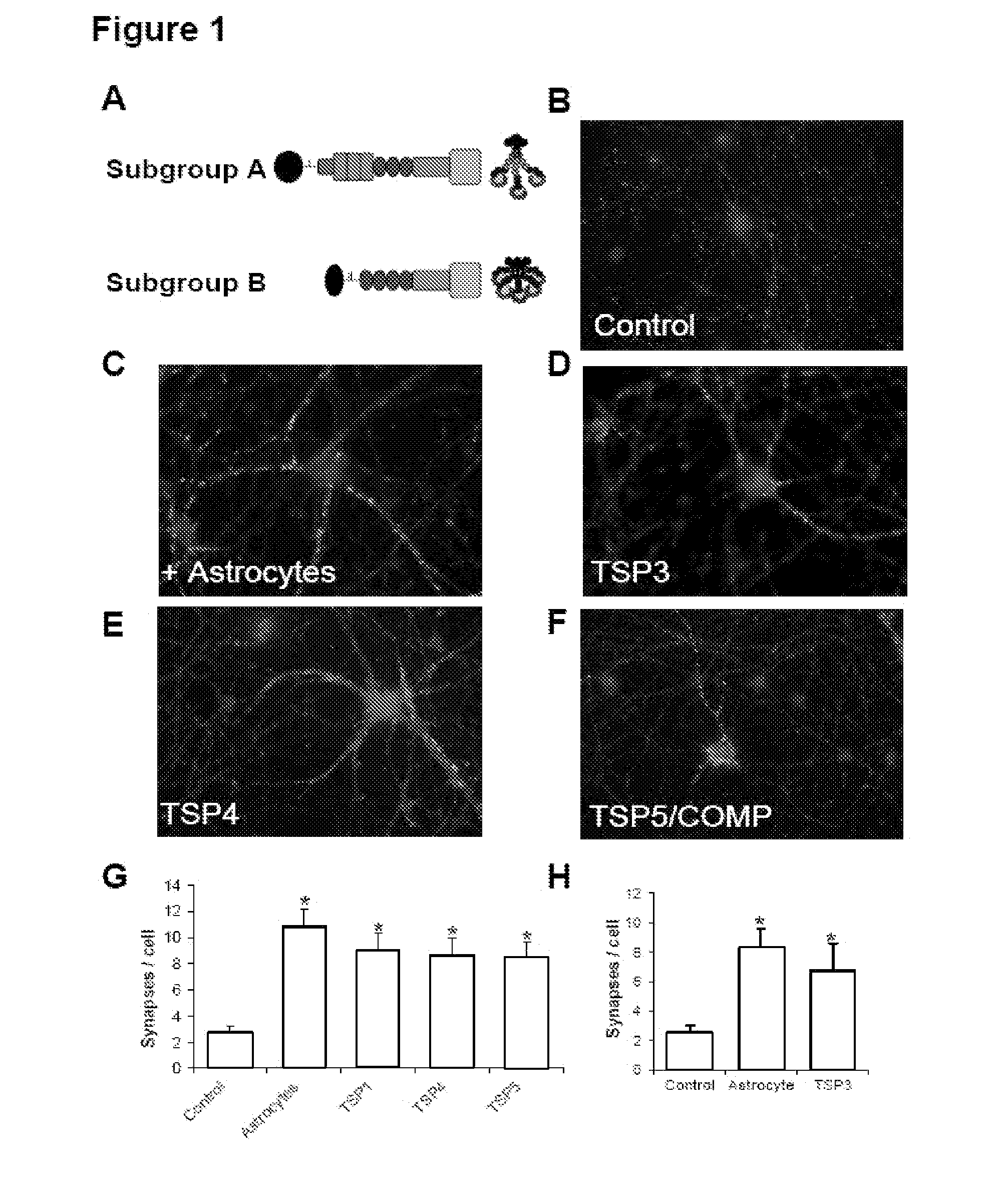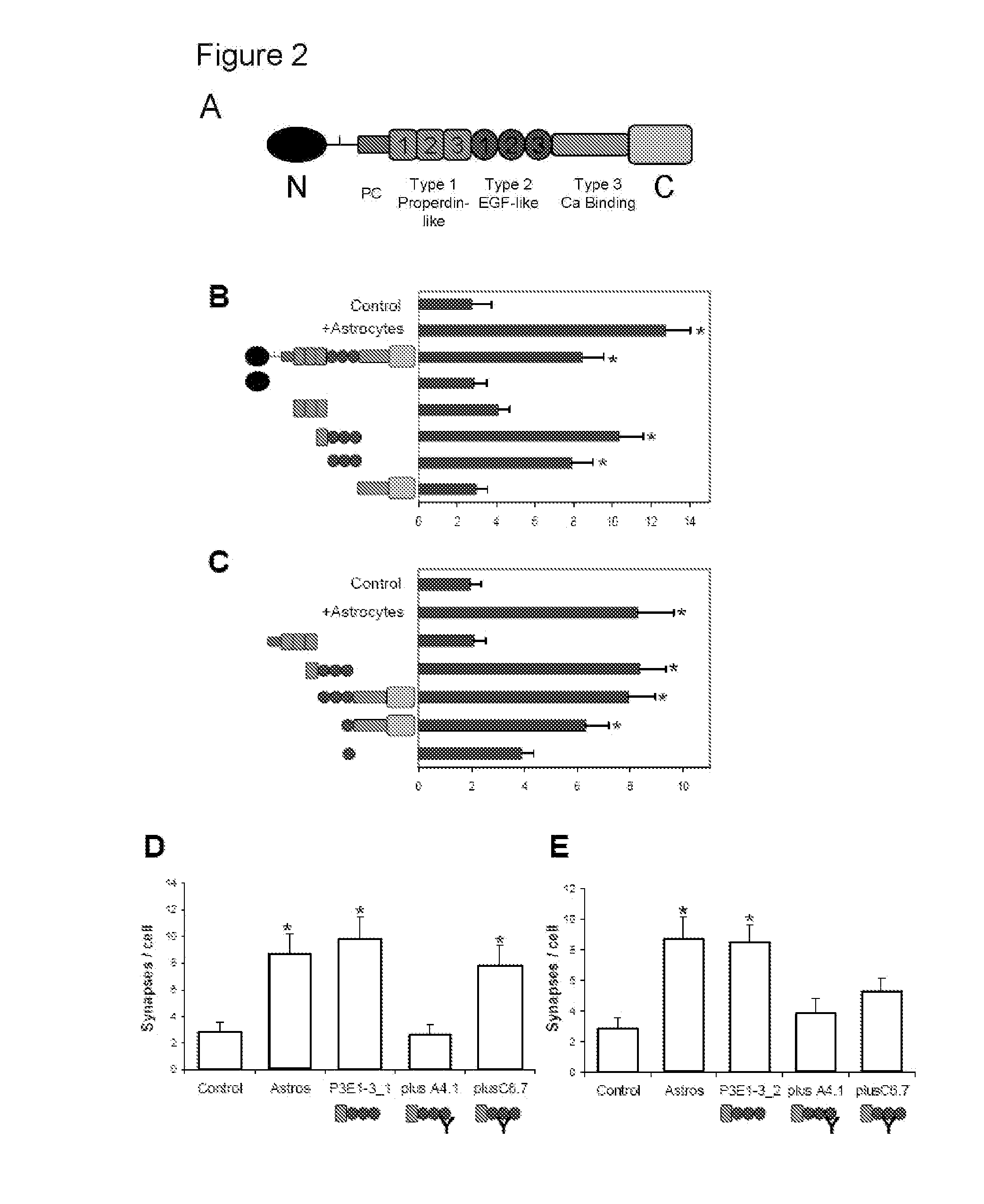Modulation of synaptogenesis
a synaptogenesis and axon technology, applied in the field of modulating synaptogenesis and axon and dendrite growth, can solve the problems of severe disruption, progressively reduced synaptic number, etc., and achieve the effect of increasing the number of individual synapses and promoting synaptogenesis
- Summary
- Abstract
- Description
- Claims
- Application Information
AI Technical Summary
Benefits of technology
Problems solved by technology
Method used
Image
Examples
example 1
[0233]The number of synapses between CNS neurons in culture is profoundly enhanced by a soluble signal secreted by astrocytes, which are identified herein as thrombospondins (TSPs), which are a necessary and sufficient component of the synapse-promoting activity of astrocyte-conditioned medium. TSPs induce ultrastructurally normal synapses that are presynaptically active but postsynaptically inactive. In vivo, TSPs are concentrated in astrocytes and at synapses throughout the developing brain, and mice deficient in both TSP1 and its ortholog TSP2 have a significant decrease in synapse number.
[0234]TSPs are large oligomeric extracellular matrix proteins, about 500 kD, that mediate cell-cell and cell-matrix interactions by binding an array of membrane receptors, other extracellular matrix proteins, and cytokines. There are five TSPs, each encoded by a separate gene. Although several TSPs are expressed in the brain, the functions of these TSPs are unknown. TSP1 and TSP2 are closely rel...
example 2
The Calcium Channel Subunit α2δ1 is the Neuronal TSP Receptor Involved in Synapse Formation
[0256]To determine whether α2δ1 plays a role in TSP-induced synapse formation in vitro, we overexpressed α2δ1 in RGCs and determined whether TSP-induced synapse formation was affected. RGCs which overexpress α2δ1 formed twice as many synapses in response to SD2 as did RGCs transfected with GFP alone (FIG. 4A) indicating that α2δ1 overexpression enhances TSP-induced synapse formation. α2δ1 overexpression alone was not sufficient to induce synapse formation in the absence of TSP indicating that TSP-α2δ1 interaction is required for the initiation of synapse formation.
[0257]To further determine whether α2δ1 is required for TSP induced synapse formation, a small interfering RNA (siRNA) knockdown approach was used. A siRNA pool specific for rat α2δ1 significantly reduced the expression of rat α2δ1 in transfected HEK293 cells (FIG. 4B). RGCs were transfected with this siRNA pool against rat α2δ1 or w...
example 3
α2δ1-Promoted Synapse Formation does Not Depend on Calcium Channel Function or Number
[0258]In order to find out whether α2δ1 promotes synapse formation through its ability to modulate biophysical properties of calcium channels, whether the δ1 subunit could still enhance TSP-induced synapse formation was tested. To do so, δ1 was overexpressed in RGCs and analyzed for its effect on SD2-induced synapse formation. Overexpression of δ1 subunit did not mimic the effect of full-length α2δ1. On the contrary, the δ1 subunit acted as a dominant negative construct and led to inhibition of SD2-induced synapse formation (FIG. 4E). Similarly, δ1 subunit expression also blocked astrocyte-induced synapse formation (data not shown). These results indicate that α2δ1 does not mediate its effect on synapse formation through modulating biophysical properties of the calcium channel. In addition, the enhancement of TSP-induced synapse formation by α2δ1 requires the presence of the α2 subunit of the recept...
PUM
| Property | Measurement | Unit |
|---|---|---|
| onset time | aaaaa | aaaaa |
| onset time | aaaaa | aaaaa |
| time | aaaaa | aaaaa |
Abstract
Description
Claims
Application Information
 Login to View More
Login to View More - R&D
- Intellectual Property
- Life Sciences
- Materials
- Tech Scout
- Unparalleled Data Quality
- Higher Quality Content
- 60% Fewer Hallucinations
Browse by: Latest US Patents, China's latest patents, Technical Efficacy Thesaurus, Application Domain, Technology Topic, Popular Technical Reports.
© 2025 PatSnap. All rights reserved.Legal|Privacy policy|Modern Slavery Act Transparency Statement|Sitemap|About US| Contact US: help@patsnap.com



